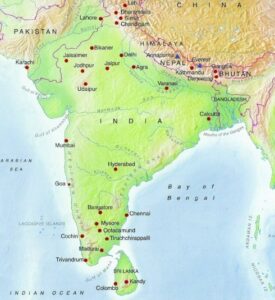How do the Deccan Traps provide information about Earth’s past and what geological processes resulted in their formation?
The Deccan Traps are a huge volcanic province in India. They formed from fissure eruptions of basalt lava 66 million years ago. They cover about 500,000 square km and are divided into three units. These formations cover a substantial portion of the Deccan Plateau and have raised questions about theiRead more
The Deccan Traps are a huge volcanic province in India. They formed from fissure eruptions of basalt lava 66 million years ago. They cover about 500,000 square km and are divided into three units. These formations cover a substantial portion of the Deccan Plateau and have raised questions about their origins and implications for our understanding of the planet’s past.
Geological Processes Leading to the Formation of the Deccan Traps
- Volcanic Activity: The genesis of the Deccan Traps can be traced back to massive volcanic eruptions that occurred approximately 66 million years ago, during the Late Cretaceous period. These eruptions, of an unprecedented scale, played a pivotal role in shaping the plateau.
- Basaltic Lava Flows: These eruptions predominantly featured basaltic lava, characterized by its low viscosity. This property allowed the lava to flow across vast distances before eventually solidifying. As a result, extensive layers of basaltic rock formed.
- Flood Basalts: The Deccan Traps earned their classification as “flood basalts” due to the staggering volume of lava discharged during the eruption phases. These floods of lava inundated the region, resulting in the expansive plateau we witness today.
- Cracking of the Earth’s Crust: The volcanic activity was triggered by the rifting or cracking of the Earth’s crust. This process created conduits for molten rock to ascend from the Earth’s mantle to the surface, setting the stage for colossal eruptions.
- Hotspot Theory: This theory posits the existence of a mantle plume, an upwelling of exceptionally hot rock from the Earth’s mantle, located beneath the Indian Plate. The heat generated by this plume led to the melting of the Earth’s crust, giving rise to volcanic activity.
- Multiple Eruption Phases: It did not arise from a single cataclysmic event but instead emerged through numerous eruption phases spanning thousands of years. These episodic eruptions deposited layer upon layer of basaltic rock, some exceeding thicknesses of 2 km.
- Massive Outpouring: During each eruption phase, immense quantities of lava were released. This deluge of molten rock contributed to the stratified nature of the Deccan Traps, with each layer representing a distinct eruption episode.
- Interplay with Tectonic Activity: The formation of the Deccan Traps was intricately linked to tectonic processes. As the Indian Plate, on which the Deccan Plateau resides, was drifting northward during this period, gradually colliding with the Eurasian Plate.
Deccan Traps offers Insights into Earth’s History in the following ways
- Mass Extinction Event: Perhaps the most striking revelation linked to the Deccan Traps is the temporal alignment between the eruptions and the mass extinction event marking the end of the Cretaceous period, notably the demise of dinosaurs.
- Climate Impact: The volcanic gases, especially sulfur dioxide, released during it’s formation, which led to the massive aerosols in the atmosphere, resulting in short-term cooling. It provides crucial insights on the relation between volcanic activity and global climatic changes.
- Continental Drift: The Deccan Traps bear witness to the movement of the Indian Plate, offering compelling evidence for the continental drift. This movement led to the formation of the Himalayan mountain range as the Indian Plate continued to collide with the Eurasian Plate.
- Environmental Adaptations: The study of fossils within the layers of the Deccan Traps offers valuable insights into how life adapted to the changing environmental conditions. It reveals a resilient and adaptable Earth system.
- Geological Timescales: The gradual buildup of these traps over millions of years serves as a testament to the immense timescales involved in geological processes. This long-term perspective challenges our understanding of time.
- Global Geological Events: Similar flood basalt events have occurred across the globe throughout Earth’s history. Studying the Deccan Traps contributes to our broader understanding of such geological events, their causes, and their consequences on a global scale.
- Volcanic Hazard Assessment: Research on ancient volcanic eruptions, like those responsible for the Deccan Traps, aids in assessing volcanic hazards in modern times. Understanding the patterns of volcanic activity, the release of volcanic gases, and their impact.
The Deccan Traps stand as a testament to the Earth’s geological complexity and its ever-evolving history. These volcanic formations offer invaluable insights into mass extinctions, climate change, tectonic movements, and the deep-seated processes that have shaped our planet over millions of years. Studying them continues to be a gateway to unlocking the mysteries of our Earth’s past.
See less

The Deccan Traps were formed through extensive volcanic activity that occurred around 66 million years ago during the late Cretaceous period. This geological phenomenon was driven by a mantle plume, which caused massive outpourings of basaltic lava over a relatively short geological timespan. The reRead more
The Deccan Traps were formed through extensive volcanic activity that occurred around 66 million years ago during the late Cretaceous period. This geological phenomenon was driven by a mantle plume, which caused massive outpourings of basaltic lava over a relatively short geological timespan. The resulting lava flows covered large areas, creating one of the largest volcanic features on Earth. These basaltic layers, known as traps due to their step-like formations, provide critical insights into Earth’s history. They offer evidence of volcanic activity’s role in shaping the planet’s surface and contributing to mass extinction events, including the one that led to the demise of the dinosaurs. The Deccan Traps also help scientists understand the processes of plate tectonics, mantle dynamics, and the long-term impact of volcanic activity on climate change, as the released gases could have caused significant atmospheric alterations.
See less